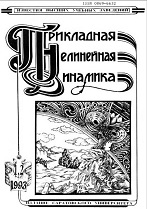|
NONLINEAR DYNAMICS AND NEUROSCIENCE
Determining of the intermittent phase synchronization degree from neurophysiological data of laboratory animals
A. D. Koloskova
Saratov State University
Abstract:
Intermittent behavior occurs near the boundaries of different types of chaotic synchronization. In this paper we present the results of investigation of intermittent phase synchronization in a real neurophysiological system. In the case of electroencephalogram (EEG) of the brain, chosen as a system under study, just the intermittent phase synchronization can indicate the existence and development of pathologies, for example, the presence of epileptic seizures. Creation and introduction of the newest methods for the analysis of various types of brain dynamics are one of the most popular and actively developing spheres in neurophysiology. EEG signals taken from the brain of a special laboratory WAG/Rij rat, which genetically predisposed to epileptic seizures, were observed. The rat is studied in two states: under the influence of the drug clonidine (results in the intensification of epileptic seizures during the first 6-12 hours, but does not affect the duration of spike-wave discharges) and without it. To estimate the degree of intermittent behavior the method based on the calculation of zero conditional Lyapunov exponent was chosen. The relation of conditional Lyapunov exponents for the phase difference of two different channels of the animal’s brain in the case of the drug influence and in their absence is found. Plots of the dependence of the investigated quantity on the number of the spike-wave discharge are constructed. It was found that the spike-wave discharges are better synchronized under the influence of the drug. The results of this work can find direct application in medicine for diagnostics and detection of diseases associated with pathological activity of the brain.
Keywords:
Intermittent phase synchronization, zero conditional Lyapunov exponent, electroencephalogram signals, epilepsy, medical drags.
Received: 04.07.2017
Citation:
A. D. Koloskova, “Determining of the intermittent phase synchronization degree from neurophysiological data of laboratory animals”, Izvestiya VUZ. Applied Nonlinear Dynamics, 25:5 (2017), 26–34
Linking options:
https://www.mathnet.ru/eng/ivp66 https://www.mathnet.ru/eng/ivp/v25/i5/p26
|

| Statistics & downloads: |
| Abstract page: | 71 | | Full-text PDF : | 30 |
|




 Contact us:
Contact us: Terms of Use
Terms of Use
 Registration to the website
Registration to the website Logotypes
Logotypes








 Citation in format
Citation in format 